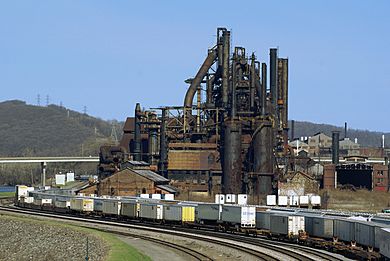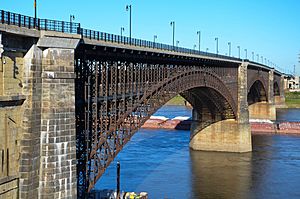History of the steel industry (1850–1970) facts for kids
Imagine a world without skyscrapers, strong bridges, or fast trains. It would be very different! Steel made these things possible. The history of the modern steel industry began in the late 1850s. Before that, steel was super expensive and only used for small, fancy items like swords. But then, new ways of making steel cheaply changed everything. This article will explore how the steel industry grew, how it affected countries, and the people who made it happen.
Contents
How Steel is Made: The Technology Story
Steel is a special metal mix, or alloy, made mostly of iron with a little bit of carbon (between 0.2% and 2.0%). For a long time, iron was made as "wrought iron," which was almost pure iron. To make steel, carbon had to be added to this iron.
But then came the blast furnace. This furnace made "pig iron," which was about 90% iron and 10% carbon. The challenge then became removing enough carbon to turn it into steel.
Before the 1860s, steel was expensive. Large buildings and structures were made from weaker iron. But two big inventions in England changed everything: the Bessemer process and the open-hearth process.
The Bessemer Process: Making Steel Cheaper
Henry Bessemer showed his new process in 1856. It was a game-changer! In the Bessemer process, hot, melted pig iron had air blown through it. This air blast burned away the extra carbon and other stuff, making the metal hotter and turning it into steel. By 1870, Bessemer steel was used for many things, like ship plates and, very importantly, strong steel rails for railways. Steel rails were much stronger and lasted longer than iron ones, allowing trains to be faster and heavier.
Newer Ways: Open-Hearth and Electric Furnaces
After 1890, the Bessemer process was slowly replaced by the open-hearth process. This method, also called the Siemens-Martin process, allowed steelmakers to control the steel's mix more carefully. It also meant they could use a lot of scrap metal, which was good for recycling!
Later, around 1900, the electric arc furnace came along. As electricity became cheaper, this furnace became popular for making special, high-quality steels.
Steel Around the World
Britain: The Early Leader
Britain was at the front of the Industrial Revolution. It had lots of coal, steam power, and railways, which all needed iron and steel. In 1875, Britain made almost half of the world's pig iron and a lot of its steel. Much of this steel was sent to the U.S. to build its railways and factories.
However, by 1896, Britain's share of world steel production dropped. The U.S. became the new leader, and Germany was catching up fast. British steel companies faced challenges, sometimes being slow to adopt new technologies like the open-hearth furnace. After World War II, the British government tried to help the steel industry by taking control of it (nationalization) to make it more efficient. But the industry still struggled with old equipment and strong competition from other countries.
Australia: Building a Nation with Steel
Australia started making steel on a small scale in the 1800s. The first large-scale steel production began in 1901 at the Eskbank Ironworks in Lithgow, New South Wales. This plant later became Australia's first full iron and steel works in 1907. The first steel rails made in Australia were rolled there in 1911.
Later, much of Australia's steel production moved to Port Kembla, New South Wales, where it still is today. In 1915, BHP, a big mining company, started its own steelworks in Newcastle, New South Wales, which operated until 1999.
Germany: The Ruhr Valley Powerhouse
The Ruhr Valley in Germany was a perfect place for the steel industry. It had plenty of raw materials like coal, good transport, skilled workers, and nearby markets. By 1850, the Ruhr had many iron works. After Germany became a united country in 1871, its steel industry grew very quickly.
Companies like Friedrich Krupp AG and Thyssen AG became huge. They combined different parts of the steel-making process to lower costs. Germany became Europe's top steel producer in the late 1800s, partly because of government support and trade groups that helped companies work together instead of competing too fiercely. By 1913, Germany was second only to the U.S. in world steel exports. After World War II, the Marshall Plan helped West Germany rebuild and modernize its steel mills, leading to rapid growth.
France and Italy: Catching Up in Europe
The French iron industry was slower to develop compared to Britain and Germany. It had many small, less efficient companies. Even with a good national income, the French steel industry didn't grow as strongly as others.
In Italy, there wasn't much coal. So, the steel industry used hydro-electric power (electricity from water) instead, using new ideas from people like Ernesto Stassano. Italy modernized its steel industry in the 1950s and 1960s, growing quickly to become the second-largest producer in Western Europe by the 1970s. Today, Italy is the world's seventh-largest steel exporter.
United States: The World Leader

From 1875 to 1920, American steel production exploded, growing from 380,000 tons to 60 million tons each year! This made the U.S. the world leader. This amazing growth happened because of new technology and a huge demand for steel to build cities, factories, railways, and bridges. Later, steel was also used in cars and home appliances.
The U.S. had lots of iron ore, especially in the Lake Superior region, and plenty of coal in states like Pennsylvania. Immigrants from Europe came in large numbers to work in the mills.
Andrew Carnegie: The Steel King
Andrew Carnegie, an immigrant from Scotland, became a giant in the steel industry. He quickly adopted the cheap and efficient Bessemer process. His cousin, George Lauder, helped him develop new systems for making steel, like cleaning coal waste. Lauder also helped build a huge armor plate mill that changed naval warfare.
Carnegie bought several mills around Pittsburgh, Pennsylvania, making it the "steel capital of the world." By the late 1880s, his company was the biggest maker of pig iron, steel rails, and coke globally. In 1901, Carnegie sold all his steel businesses. They were combined into a new company called US Steel.
US Steel and Bethlehem Steel
In 1901, J. P. Morgan created US Steel, which became the world's largest steel company for many decades. It combined Carnegie's company with many other major steel firms. US Steel produced a huge amount of steel, even more than all German and Austrian companies combined during World War I.
Bethlehem Steel became the second-largest American steel company by the 1920s, led by Charles M. Schwab and Eugene Grace. Bethlehem focused on big government projects, like building ships and naval armor, and making steel beams for skyscrapers and bridges. During World War II, its shipyards built more ships than any other company.
Unions and Decline
Workers in the steel industry tried to form unions to get better pay and working conditions. A big strike in 1919 failed, but unions grew stronger in the late 1930s. The United Steelworkers of America became a powerful union.
By the 1960s, the American steel industry faced tough competition from countries with lower wages. Imports and smaller, local "mini-mills" hurt sales. Most big mills closed down. Bethlehem Steel went bankrupt in 2001. US Steel became much smaller, with far fewer workers. The world steel industry faced challenges, especially after 2008, when demand for steel dropped sharply.
Asia: New Steel Giants
Japan: From Feudal to Modern
The steel industry was key to Japan's amazing economic growth. From the late 1800s, when Japan changed from an old-fashioned society to a modern one, through its industrial growth and after World War II, steel was essential. Industries like shipbuilding and car manufacturing relied heavily on steel. Japan became the world's third-largest steel producer by 1970. The Japanese government played a big role in helping steel companies grow and adopt new technologies.
India: Growing Fast
The first iron works in India started in 1870. The Tata Iron and Steel Company (TISCO) was founded in 1907 and became the largest steel plant in the British Empire by 1939. After India became independent, Prime Minister Jawaharlal Nehru believed that making more steel was crucial for India's progress. So, the government set up its own steel company, Hindustan Steel Limited, and built three new plants in the 1950s. In the 21st century, Indian steel companies like Tata Steel and ArcelorMittal (which has Indian management) became some of the biggest in the world.
China: A Huge Leap in Steel
In 1958, Chinese leader Mao Zedong wanted China to quickly become a major steel producer. He tried to double steel production using small "backyard steel furnaces" run by farmers. This plan was a disaster because the steel made was very poor quality, and it took resources away from farming, leading to a terrible famine.
However, after Deng Xiaoping introduced economic reforms in the late 1970s, China began to build a modern steel industry. It built new, large steel plants and recycled scrap metal. By 2013, China produced an incredible 779 million metric tons of steel each year, making it by far the largest steel-producing country in the world. This was more than the European Union, Japan, the United States, and India combined!
Images for kids
See also
- American Iron and Steel Institute
- British Steel Corporation
- Dominion Steel and Coal Corporation, in Canada
- Steelmaking




